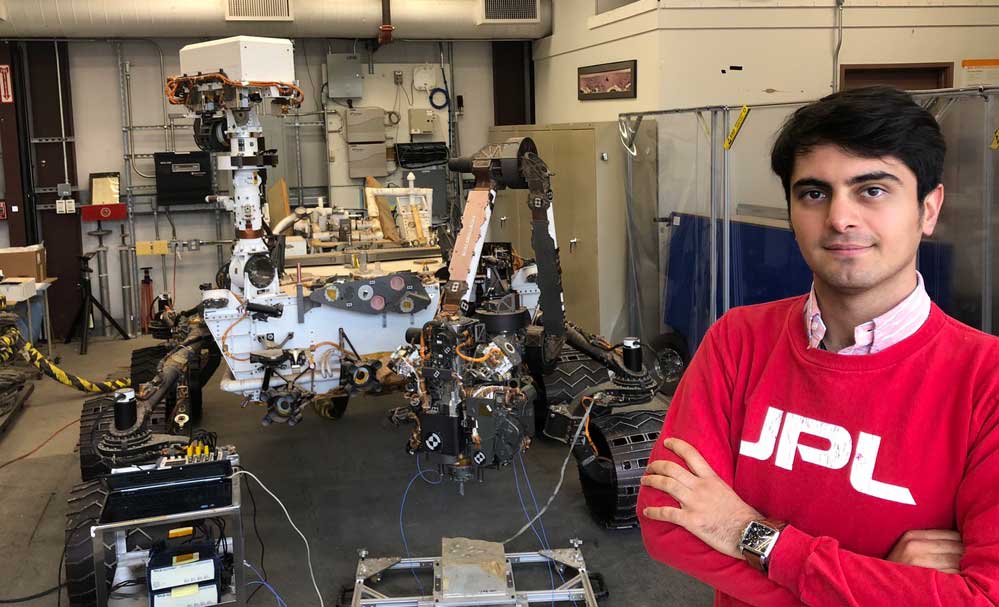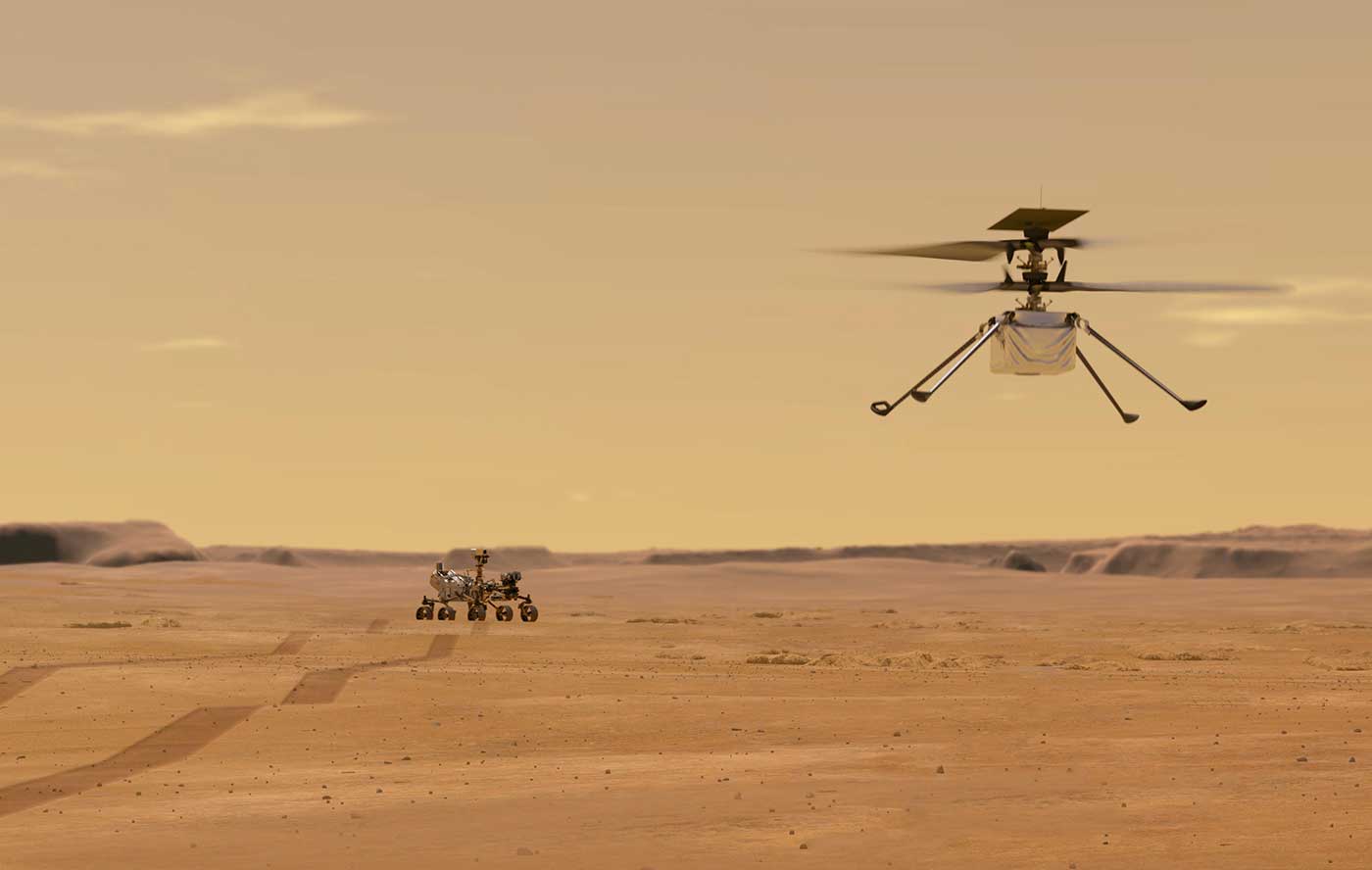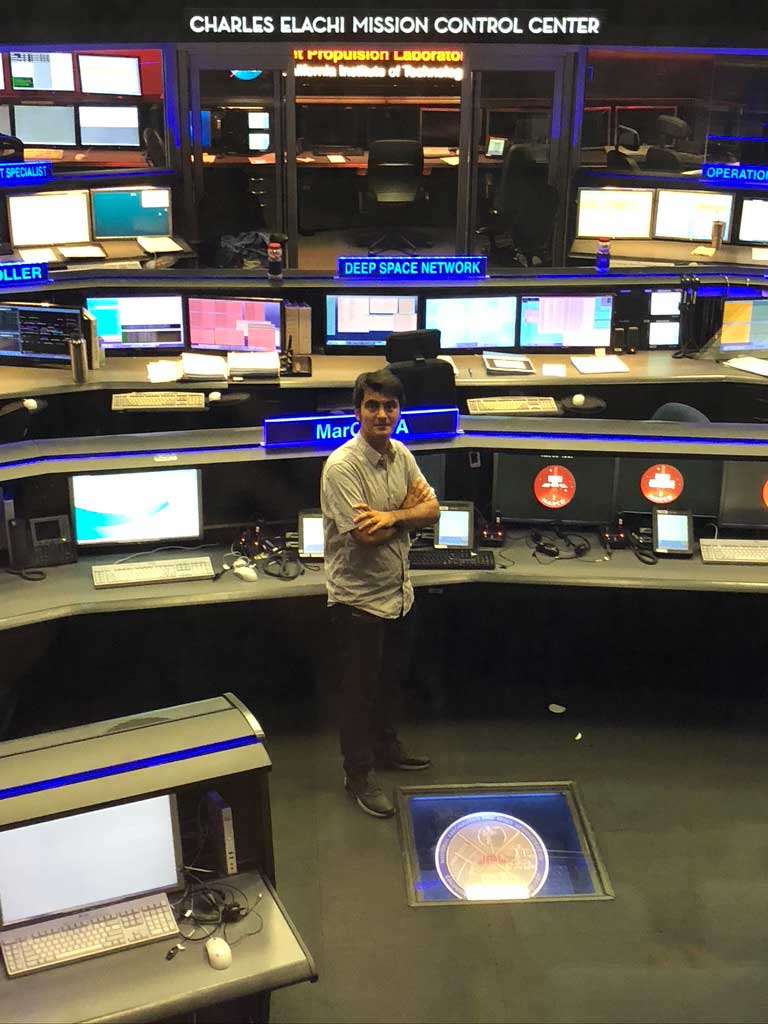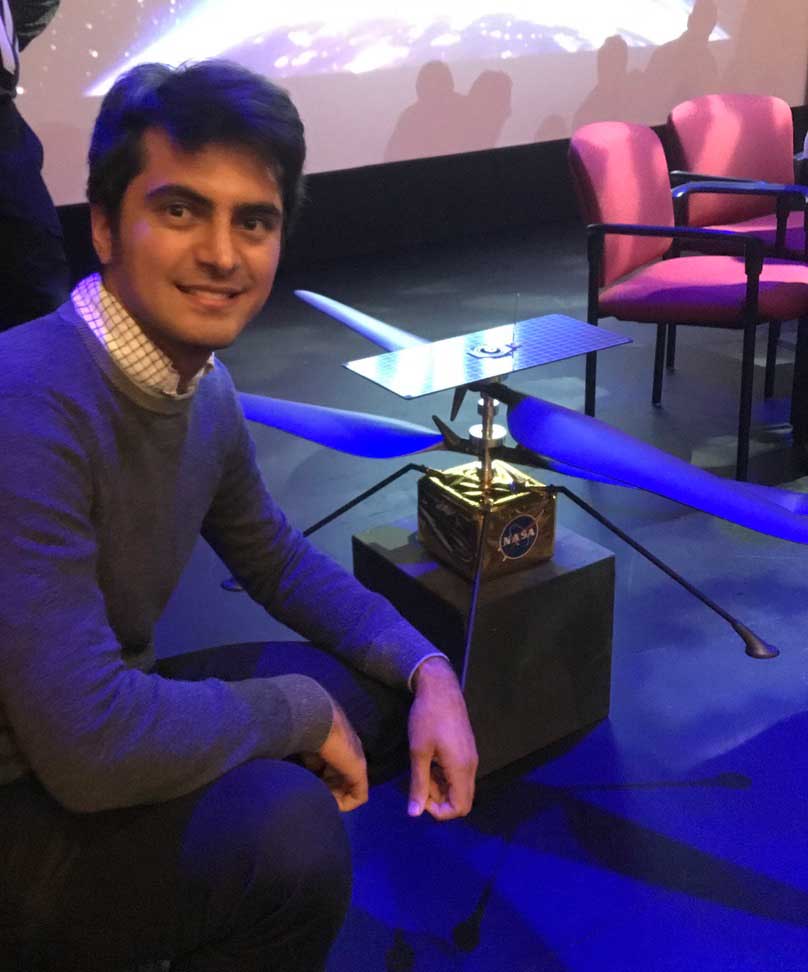
By:
- Ioana Patringenaru
Published Date
By:
- Ioana Patringenaru
Share This:

Ryan Alimo earned a Ph.D. from UC San Diego and is now a data scientist and project leader at NASA's JPL. Photos courtesy of Ryan Alimo/NASA JPL.
From San Diego to Mars
Engineering alumnus describes his journey to becoming part of the Mars Exploration team
When he was 14 years old and a junior high school student in Iran in 2004, Ryan Alimo watched the twin Spirit and Opportunity NASA rovers land on Mars. The young Alimo was watching with his father and both were struck by how happy everyone looked at Mission Control. “I want to see you one day in that position,” Alimo’s father told him. “These people are the happiest people in the world right now.”
Fast forward 17 years, and Alimo got to watch the landing of the Perseverance rover on a private channel in a conference room at the Jet Propulsion Laboratory in Pasadena, Calif., where he now works.
“It was an emotional moment,” said Alimo, who earned his Ph.D. in computational science at the University of California San Diego in 2017. “A few months back, we were testing the rover outside my office. Now, it’s on another planet.”
Between first watching the rovers in 2004 and being part of the team, Alimo transformed himself from a mediocre student to an astronomy expert his classmates called “The Martian.” He became one of the youngest students to win Iran’s national astronomy Olympiad competition in 2005. Alimo studied engineering as an undergraduate at Sharif University in Iran, focusing on numerical computation before joining UC San Diego in 2012.
After his family emigrated to the United States in 2011, he contacted the program manager on the Spirit and Opportunity rovers and told him about his dream. Much to his surprise, the manager of the Mars missions and the director for solar system exploration, Firouz Naderi, offered to give him a tour of the JPL campus and became his mentor. Alimo decided to pursue graduate school at UC San Diego, where he earned a master’s degree in mechanical engineering in the lab of Professor Alison Marsden, and a Ph.D. in the research group of Professor Thomas Bewley. This led him to a postdoc at the California Institute of Technology’s Center for Autonomous Systems and Technology (CAST) and finally a job as a data scientist and project leader at NASA’s JPL.
Alimo views his experiences as a lesson in having a goal and sticking to it. “It shows the value and importance of having a vision,” he said.

Alimo worked on both the Perseverance rover and the Ingenuity helicopter. Graphic courtesy of NASA.
At JPL, Alimo’s team developed an AI system that finds data errors quickly and reliably, so Perseverance and Ingenuity can move faster. Data from Ingenuity follows a complex and multi-stage path: from the helicopter to the rover, to the satellites orbiting Mars, to Deep Space Network (DSN) stations back on Earth, and finally to mission control at JPL. DSN stations consist of huge radio antennas located in California, Australia and Spain that receive data and send commands to the Mars rovers. As a Ph.D student at UC San Diego, Alimo designed optimization algorithms to automate and optimize the performance of complex and nonlinear systems, which were later used at NASA to automate and optimize data transmission for Mars.
Ingenuity’s first flight was very much a Wright Brother moment—but on Mars. Technologists weren’t sure how well Ingenuity and Perseverance would work together. The fact that the mission came together during a pandemic, when many worked from home, is amazing, Alimo said.
Looking forward, Alimo is focusing on two projects. One explores how a swarm of multiple spacecraft can work together to perform complicated tasks. Could you, for example, have thousands of small satellites work together to take a picture for an exoplanet? The other investigates how different classes of robots can work together to explore underground caves on other planets.
Meetings at JPL can feel surreal, he said.
“We have meetings where we talk about diving and driving on icy moons, Europa, Enceladus, or flying on Titan and Mars,” Alimo said. “We want to go to other planets.”
Alimo said he feels like NASA and JPL can realize these goals.
“It’s good to dream big,” he said.
We asked Alimo for advice for students considering graduate school and those who just finished their Ph.D. Here is our Q&A below.

Alimo at JPL's mission control center, where he had dreamed to work as a child.
Q. How did you decide to get your Ph.D. at UC San Diego?’
A. I had different offers to go to graduate school. But I wanted to be in La Jolla, because it looked like a good place to live for five years, and I had friends there. Even though UC San Diego doesn’t have a strong space program, it brings together mechanical engineering and aerospace engineering. I first heard of Professor Marsden because I knew of her father’s contributions to space science, controls and celestial mechanics. She was my academic mother and Professor Bewley was my academic father. I learned so much from them.
Q. How did you go about getting more experience in space research at UC San Diego?
A. While working with Professor Marsden, I was able to volunteer in the lab of Professor Allen Hargans at the School of Medicine, who studies the health of astronauts. I sought out Professor Bewley because he has many connections with JPL and NASA.
Q. What would you advise Ph.D. students to study and specialize in?
A. The world is changing and requires more skilled people. Your Ph.D. is an investment. It’s different right now than it was a few decades ago. It’s not just for an academic career. It’s also something you can use in industry.
I would advise them to pursue a study that is applicable to many fields. Because the topic of my Ph.D. was general, data-driven optimization algorithms, I had the option to enter different fields and collaborate with other industries including bioengineering, gas/oil, spacecraft autonomy, cybersecurity, flying vehicles, AI, and deep learning.
Also think outside of the box: you don’t need to be in a computer science department to study AI and machine learning. You can choose other departments where admissions are easier and collaborate with computer scientists.
I also want to emphasize that a Ph.D. is only half technical contributions. The other half is learning social skills, learning how to present. It’s important to pay attention to both of these things.

Alimo with a model of the Ingenuity helicopter.
Q. Conversely, what advice would you give to someone who just earned their Ph.D. or is about to, and is looking for a job in industry?
A. You should think about what excites you the most. Think about something you could do for 80 hours per week.
I also would stress that you need to establish connections to find your dream job.
After my Ph.D., I interviewed at many places, from hedge funds in the Midwest to self-driving car companies and semiconductor companies in the Bay Area. Apply to as many jobs as you can. Interviewing at different places with different people enables you to understand how broad industry is and where exactly you can go. The job market these days is like taking a GRE or SAT exam: you should prepare. There are even some books for interview preparation that you can read.
In my case, I chose the job that I really like. Every day when I go to work, I don’t feel that I am working. The most boring meetings that we have are about how we can go to the Moon, Mars, Europa, and Enceladus! You are spending the majority of your life at work, especially after a Ph.D., you are probably in your 20s and 30s, which is supposed to be one of the best periods in your life. So you should love your job.
If you cannot find your dream job after graduation, I highly suggest going to a research lab or doing a very short postdoc after your Ph.D. This enables you to choose your path afterward whatever that may be, whether you want to go to academia or private industry. These days academic institutions want to get applicants who have had an industrial background. The advantage of research labs is that you get paid much more compared to a postdoc, but you are also performing research. On the other hand, if you choose to go into private industry, I suggest you consider joining an early-stage startup or establishing your own business and follow your passion and dream.
Share This:
You May Also Like
Stay in the Know
Keep up with all the latest from UC San Diego. Subscribe to the newsletter today.


